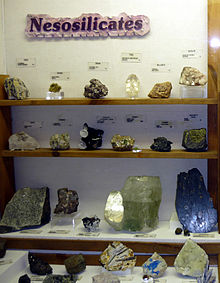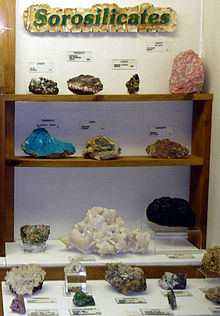- Silicate minerals
-
The silicate minerals make up the largest and most important class of rock-forming minerals, constituting approximately 90 percent of the crust of the Earth. They are classified based on the structure of their silicate group. Silicate minerals all contain silicon and oxygen.
 Phyllosilicate mineral Chrysocolla
Phyllosilicate mineral Chrysocolla
Contents
Nesosilicates or orthosilicates
Main category: NesosilicatesNesosilicates (from Greek νησος nēsos, island), or orthosilicates, have isolated (insular) [SiO4]4− tetrahedra that are connected only by interstitial cations. Nickel-Strunz classification: 09.A
- Phenakite group
- Olivine group
- Forsterite - Mg2SiO4
- Fayalite - Fe2SiO4
- Garnet group
- Pyrope - Mg3Al2(SiO4)3
- Almandine - Fe3Al2(SiO4)3
- Spessartine - Mn3Al2(SiO4)3
- Grossular - Ca3Al2(SiO4)3
- Andradite - Ca3Fe2(SiO4)3
- Uvarovite - Ca3Cr2(SiO4)3
- Hydrogrossular - Ca3Al2Si2O8(SiO4)3-m(OH)4m
- Zircon group
 Kyanite crystals (unknown scale)
Kyanite crystals (unknown scale)
- Al2SiO5 group
- Andalusite - Al2SiO5
- Kyanite - Al2SiO5
- Sillimanite - Al2SiO5
- Dumortierite - Al6.5-7BO3(SiO4)3(O,OH)3
- Topaz - Al2SiO4(F,OH)2
- Staurolite - Fe2Al9(SiO4)4(O,OH)2
- Humite group - (Mg,Fe)7(SiO4)3(F,OH)2
- Norbergite - Mg3(SiO4)(F,OH)2
- Chondrodite - Mg5(SiO4)(F,OH)2
- Humite - Mg7(SiO4)(F,OH)2
- Clinohumite - Mg9(SiO4)(F,OH)2
- Datolite - CaBSiO4(OH)
- Titanite - CaTiSiO5
- Chloritoid - (Fe,Mg,Mn)2Al4Si2O10(OH)4
Sorosilicates
Main category: SorosilicatesSorosilicates have isolated double tetrahedra groups with (Si2O7)6− or a ratio of 2:7. Nickel-Strunz classification: 09.B
- Hemimorphite (calamine) - Zn4(Si2O7)(OH)2·H2O
- Lawsonite - CaAl2(Si2O7)(OH)2·H2O
- Ilvaite - CaFe2+2Fe3+O(Si2O7)(OH)
- Epidote group (has both (SiO4)4− and (Si2O7)6− groups)
- Epidote - Ca2(Al,Fe)3O(SiO4)(Si2O7)(OH)
- Zoisite - Ca2Al3O(SiO4)(Si2O7)(OH)
- Clinozoisite - Ca2Al3O(SiO4)(Si2O7)(OH)
- Tanzanite - Ca2Al3O(SiO4)(Si2O7)(OH)
- Allanite - Ca(Ce,La,Y,Ca)Al2(Fe2+,Fe3+)O(SiO4)(Si2O7)(OH)
- Dollaseite-(Ce) - CaCeMg2AlSi3O11F(OH)
- Vesuvianite (idocrase) - Ca10(Mg,Fe)2Al4(SiO4)5(Si2O7)2(OH)4
Cyclosilicates
Main category: CyclosilicatesCyclosilicates, or ring silicates, have linked tetrahedra with (SixO3x)2x- or a ratio of 1:3. These exist as 3-member (Si3O9)6-, 4-member (Si4O12)8- and 6-member (Si6O18)12- rings. Nickel-Strunz classification: 09.C
- 3-member ring
- Benitoite - BaTi(Si3O9)
- 4-member ring
- Axinite - (Ca,Fe,Mn)3Al2(BO3)(Si4O12)(OH)
- 6-member ring
- Beryl/Emerald - Be3Al2(Si6O18)
- Cordierite - (Mg,Fe)2Al3(Si5AlO18)
- Tourmaline - (Na,Ca)(Al,Li,Mg)3-(Al,Fe,Mn)6(Si6O18)(BO3)3(OH)4
Inosilicates
Main category: InosilicatesInosilicates (from Greek ις [genitive: ινος inos], fibre), or chain silicates, have interlocking chains of silicate tetrahedra with either SiO3, 1:3 ratio, for single chains or Si4O11, 4:11 ratio, for double chains. Nickel-Strunz classification: 09.D
Single chain inosilicates
- Pyroxene group
- Pyroxenoid group
- Wollastonite - CaSiO3
- Rhodonite - MnSiO3
- Pectolite - NaCa2(Si3O8)(OH)
Double chain inosilicates
- Amphibole group
- Anthophyllite - (Mg,Fe)7Si8O22(OH)2
- Cumingtonite series
- Cummingtonite - Fe2Mg5Si8O22(OH)2
- Grunerite - Fe7Si8O22(OH)2
- Tremolite series
- Tremolite - Ca2Mg5Si8O22(OH)2
- Actinolite - Ca2(Mg,Fe)5Si8O22(OH)2
- Hornblende - (Ca,Na)2-3(Mg,Fe,Al)5Si6(Al,Si)2O22(OH)2
- Sodium amphibole group
- Glaucophane - Na2Mg3Al2Si8O22(OH)2
- Riebeckite (asbestos) - Na2Fe2+3Fe3+2Si8O22(OH)2
- Arfvedsonite - Na3(Fe,Mg)4FeSi8O22(OH)2
Phyllosilicates
Main category: PhyllosilicatesPhyllosilicates (from Greek φύλλον phyllon, leaf), or sheet silicates, form parallel sheets of silicate tetrahedra with Si2O5 or a 2:5 ratio. Nickel-Strunz classification: 09.E
- Serpentine group
- Antigorite - Mg3Si2O5(OH)4
- Chrysotile - Mg3Si2O5(OH)4
- Lizardite - Mg3Si2O5(OH)4
- Clay mineral group
- Halloysite - Al2Si2O5(OH)4
- Kaolinite - Al2Si2O5(OH)4
- Illite - (K,H3O)(Al,Mg,Fe)2(Si,Al)4O10[(OH)2,(H2O)]
- Montmorillonite - (Na,Ca)0.33(Al,Mg)2Si4O10(OH)2·nH2O
- Vermiculite - (MgFe,Al)3(Al,Si)4O10(OH)2·4H2O
- Talc - Mg3Si4O10(OH)2
- Palygorskite - (Mg,Al)2Si4O10(OH)·4(H2O)
- Pyrophyllite - Al2Si4O10(OH)2
- Mica group
- Biotite - K(Mg,Fe)3(AlSi3)O10(OH)2
- Muscovite - KAl2(AlSi3)O10(OH)2
- Phlogopite - KMg3(AlSi3)O10(OH)2
- Lepidolite - K(Li,Al)2-3(AlSi3)O10(OH)2
- Margarite - CaAl2(Al2Si2)O10(OH)2
- Glauconite - (K,Na)(Al,Mg,Fe)2(Si,Al)4O10(OH)2
- Chlorite group
- Chlorite - (Mg,Fe)3(Si,Al)4O10(OH)2•(Mg,Fe)3(OH)6
Tectosilicates
Main category: TectosilicatesTectosilicates, or "framework silicates," have a three-dimensional framework of silicate tetrahedra with SiO2 or a 1:2 ratio. This group comprises nearly 75% of the crust of the Earth. Tectosilicates, with the exception of the quartz group, are aluminosilicates. Nickel-Strunz classification: 09.F and 09.G, 04.DA (Quartz/ silica family)
 Lunar Ferroan Anorthosite #60025 (Plagioclase Feldspar). Collected by Apollo 16 from the Lunar Highlands near Descartes Crater.
Lunar Ferroan Anorthosite #60025 (Plagioclase Feldspar). Collected by Apollo 16 from the Lunar Highlands near Descartes Crater.
- Quartz group
- Quartz - SiO2
- Tridymite - SiO2
- Cristobalite - SiO2
- Feldspar family
- Alkali-feldspars
- Potassium-feldspars
- Microcline - KAlSi3O8
- Orthoclase - KAlSi3O8
- Sanidine - KAlSi3O8
- Anorthoclase - (Na,K)AlSi3O8
- Potassium-feldspars
- Plagioclase feldspars
- Albite - NaAlSi3O8
- Oligoclase - (Na,Ca)(Si,Al)4O8 (Na:Ca 4:1)
- Andesine - (Na,Ca)(Si,Al)4O8 (Na:Ca 3:2)
- Labradorite - (Na,Ca)(Si,Al)4O8 (Na:Ca 2:3)
- Bytownite - (Na,Ca)(Si,Al)4O8 (Na:Ca 1:4)
- Anorthite - CaAl2Si2O8
- Alkali-feldspars
- Feldspathoid family
- Petalite - LiAlSi4O10
- Scapolite group
- Analcime - NaAlSi2O6•H2O
- Zeolite group
- Natrolite - Na2Al2Si3O10•2H2O
- Chabazite - CaAl2Si4O12•6H2O
- Heulandite - CaAl2Si7O18•6H2O
- Stilbite - NaCa2Al5Si13O36•17H2O
See also
- Classification of minerals - Non silicates
- Classification of minerals - Silicates
- Silicate mineral paint
References
- Deer, W.A.; Howie, R.A., & Zussman, J. (1992). An introduction to the rock-forming minerals (2nd ed.). London: Longman. ISBN 0582300940.
- Deer, W.A.; Howie, R.A., Wise, W.S. & Zussman, J. (2004). Rock-forming minerals. Volume 4B. Framework silicates: silica minerals. Feldspathoids and the zeolites (2nd ed.). London: Geological Society of London. p. 982 pp.
- Hurlbut, Cornelius S. (1966). Dana's Manual of Mineralogy (17th ed.). ISBN 0-471-03288-3.
- Hurlbut, Cornelius S.; Klein, Cornelis (1985). Manual of Mineralogy (20th ed.). Wiley. ISBN 0-471-80580-7.
External links
 Media related to Silicates at Wikimedia Commons
Media related to Silicates at Wikimedia CommonsIMA/CNMNC – Nickel–Strunz – Mineral Classes Non silicates 01 Elements · 02 Sulfides · 02 Sulfosalts · 03 Halides · 04 Oxides · 04 Hydroxides · 04 Arsenites · 05 Carbonates · 05 Nitrates · 06 Borates · 07 Sulfates · 07 Chromates · 07 Molybdates · 07 Tungstates · 08 Phosphates · 08 Arsenates · 08 Vanadates · 10 Organic compoundsSubclasses of silicates 09.A Nesosilicates · 09.B Sorosilicates · 09.C Cyclosilicates · 09.D Inosilicates · 09.E Phyllosilicates · 09.F Tectosilicates without zeolitic H2O · 09.G Tectosilicates with zeolitic H2O · 09.H Unclassified silicates · 09.J GermanatesCategories:
Wikimedia Foundation. 2010.





